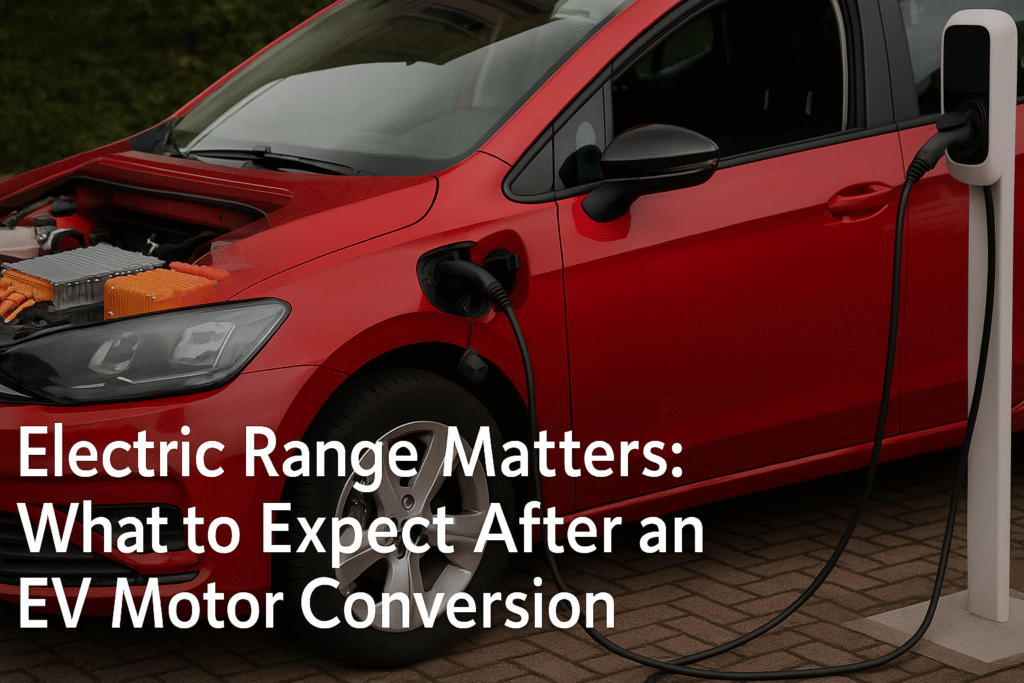As interest in electric vehicles continues to rise, many drivers are asking an important question: Can I convert my diesel car into an EV and still enjoy a decent driving range? The short answer is yes—but there are key factors you need to understand first.
EV conversion is becoming an increasingly popular alternative for car enthusiasts, sustainability advocates, and budget-conscious drivers alike. Whether you’re restoring a classic car or simply upgrading your daily driver, converting a traditional diesel car into an electric one is not only possible—it’s a pathway to a cleaner, quieter, and more efficient ride.
In this guide, we’ll break down what affects your electric range after an EV conversion, the role of components like the EV motor and electric engine, and what to know about battery replacement cost down the road.
EV Conversion and Its Impact on Range
EV conversion refers to the process of replacing your vehicle’s internal combustion engine—typically a gasoline or diesel engine—with an electric drivetrain. This includes a battery pack, electric motor(s), and control systems that work together to power your car without emissions.
But how far can you go on a single charge after a conversion? That’s where electric range becomes a critical factor. Your range depends on several variables, including:
- Battery capacity (kWh)
- Type of EV motor and efficiency
- Weight and size of your vehicle
- Driving habits and terrain
While factory-made EVs often have a range of 200–350 miles, converted vehicles usually fall between 75–150 miles depending on your setup. However, with advanced EV conversion kits and modern lithium-ion batteries, you can get closer to commercial EV range numbers.
Diesel Car to EV: What to Expect in Performance
Converting a diesel car to electric is not just about cutting emissions—it’s about redefining your driving experience. Diesel engines are known for their torque and fuel efficiency, but they are loud, heavy, and contribute significantly to air pollution. An electric engine, on the other hand, offers instant torque, silent operation, and smoother acceleration.
Here’s what changes when you go electric:
- No more fuel stops: Say goodbye to gas stations.
- Less maintenance: No oil changes, timing belts, or exhaust system repairs.
- Better torque: The EV motor delivers power instantly.
- Lower operating cost: Charging is often cheaper than filling up with diesel.
However, you may also face range anxiety if your electric range is limited—especially on long road trips. That’s why understanding your driving needs and choosing the right components is crucial.
Choosing the Right EV Conversion Kits
One of the most important factors that influence electric range is the EV conversion kit you choose. A conversion kit typically includes:
- EV motor (AC or DC)
- Electric engine controller
- Battery pack and charger
- Wiring, brackets, and cooling system
When shopping for EV conversion kits, pay close attention to battery size and motor specs. A higher voltage system (e.g., 144V or more) with a larger battery (e.g., 40 kWh) will usually provide better range—but it may also be heavier and more expensive.
Popular options include:
- Budget kits: Good for short commutes (50–75 miles of range)
- Mid-range kits: Offer around 100–150 miles per charge
- Performance kits: Can rival commercial EVs with 200+ miles of range
If you’re converting a heavier diesel car, you’ll likely need a high-torque motor and a larger battery pack to match its weight and driving demands.
How the EV Motor and Electric Engine Affect Range
Let’s clear something up: the terms EV motor and electric engine are often used interchangeably, but in this context, both refer to the component that drives your car after conversion.
The type of motor you choose—AC (alternating current) vs DC (direct current)—plays a big role in your range and efficiency:
- DC motors: Simpler and cheaper, good for light city driving
- AC motors: More efficient and regenerative braking capable, ideal for longer ranges
An efficient electric engine paired with a high-capacity battery and lightweight design can stretch your electric range dramatically. Think of it as a performance puzzle where every piece matters.
What Affects Electric Range After Conversion?
Many drivers assume the battery alone determines how far they can drive, but several factors come into play:
- Vehicle Weight: Heavier cars, especially older diesel models, consume more power to move.
- Battery Type and Age: Modern lithium-ion batteries last longer and charge faster than older lead-acid ones.
- Driving Style: Aggressive driving and high speeds drain batteries faster.
- Tire Pressure and Aerodynamics: Under-inflated tires and drag can reduce range.
- Climate: Cold weather reduces battery efficiency and range.
If your converted EV isn’t reaching its expected range, check these areas first.
Battery Replacement Cost: What You Need to Know
One of the most common concerns about EV ownership—converted or not—is the battery replacement cost. Batteries degrade over time and may need replacing after 8–10 years depending on usage.
Here’s what to expect:
- Basic battery pack (15–20 kWh): $3,000 – $6,000
- Larger battery pack (30–60 kWh): $7,000 – $12,000+
- Used or refurbished options: May cut costs by up to 40%
While this may sound expensive, it’s worth noting that you’ll save significantly on fuel and maintenance over the life of the vehicle. Plus, battery technology is evolving fast, and prices are gradually decreasing.
Is EV Conversion Right for You?
EV conversion is not for everyone. If you’re looking for a plug-and-play solution with a long electric range, a factory-made EV might be a better choice. However, if you love your current diesel car, want to reduce your carbon footprint, and enjoy a hands-on project, conversion can be deeply rewarding.
Just remember:
- Start with a plan: Know your range goals, budget, and usage needs.
- Choose quality parts: Invest in proven EV conversion kits with good customer support.
- Consult professionals: A certified technician can help with installation and battery integration.
- Think long-term: Consider future battery replacement costs and charging infrastructure.
Final Thoughts: Drive Clean, Drive Smart
Whether you’re upgrading an old diesel car or building a sleek custom EV from scratch, remember: going electric isn’t just about saving money or helping the environment—it’s about creating a driving experience that fits your lifestyle. At nexgenwheels, we believe in empowering drivers with the knowledge and tools they need to embrace the future of mobility. From understanding EV motors to exploring real-world electric range, nexgenwheels is your go-to source for everything related to electric conversions and beyond.


